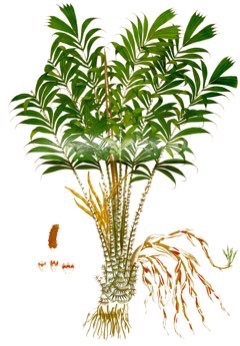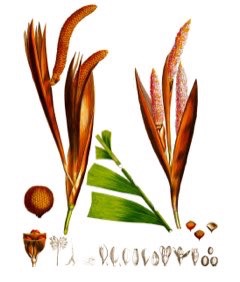 |
|
http://www.edibleplants.org |
 |
| http://www.edibleplants.org |
Translate this page:
Summary
Salak Palm, Salacca zalacca, is a short-stemmed palm native to Java and Sumatra in Indonesia. It has long erect leaves up to 6m long, with each leaf having 2m long petiole with spines and leaflets. The trunk is underground. The fruits, which occur in clusters at the base of the palm, are characterized by its reddish-brown scaly skin. It can be eaten raw when fully ripe or made into candies. Unripe fruits, on the other hand, are used in salads. Among the about 30 cultivars of this plant, there are two popular cultivars named as salad poncho and salad Bali. There are no reported medicinal uses of Salak Palm. The leaflets are used for thatching and the bark of the petioles are used for matting.
Physical Characteristics

 Salacca zalacca is an evergreen Shrub growing to 4 m (13ft) by 4 m (13ft) at a fast rate.
Salacca zalacca is an evergreen Shrub growing to 4 m (13ft) by 4 m (13ft) at a fast rate.
See above for USDA hardiness. It is hardy to UK zone 10. The flowers are pollinated by Insects.
Suitable for: light (sandy) and medium (loamy) soils and prefers well-drained soil. Suitable pH: mildly acid and neutral soils and can grow in very acid soils.
It can grow in semi-shade (light woodland) or no shade. It prefers moist soil.
UK Hardiness Map
US Hardiness Map
Synonyms
Salacca edulis Reinw.
Plant Habitats
Edible Uses
Edible Parts: Fruit Seed
Edible Uses:
Fruit - raw[297 ]. An acid flavour[297 ]. Slightly crisp, with a delicious blend of acids and sugars and an apple-like flavour[200 , 301 ] The flesh is exceptionally firm and crisp for a tropical fruit[303 ]. It is quite sweet when fully ripe, but the unripe fruit is sour and astringent due to the presence of a little tannic acid[303 ]. Considered to be one of the finest of palm fruits for eating raw[301 ]. In Indonesia the fruits are also candied ('manisan salak'), pickled ('asinan salak') and fresh unripe ones may be used in 'rujak', a spicy salad of unripe fruit[303 ]. The reddish-brown, ovoid fruit is 6 - 8cm in diameter[200 ]. The seed is edible[301 ]. The seed kernels of the young fruits of the Javanese 'Pondoh' form are edible[303 ].
References More on Edible Uses
Medicinal Uses
Plants For A Future can not take any responsibility for any adverse effects from the use of plants. Always seek advice from a professional before using a plant medicinally.
None known
References More on Medicinal Uses
The Bookshop: Edible Plant Books
Our Latest books on Perennial Plants For Food Forests and Permaculture Gardens in paperback or digital formats.

Edible Tropical Plants
Food Forest Plants for Hotter Conditions: 250+ Plants For Tropical Food Forests & Permaculture Gardens.
More

Edible Temperate Plants
Plants for Your Food Forest: 500 Plants for Temperate Food Forests & Permaculture Gardens.
More

More Books
PFAF have eight books available in paperback and digital formats. Browse the shop for more information.
Shop Now
Other Uses
Fencing Hedge Thatching
Agroforestry Uses: A closely-planted row of palms forms an impregnable hedge and the very spiny leaves are also cut to construct fences[303 ]. Other Uses The bark of the petioles may be used for matting[303 ]. The leaflets are used for thatching[303 ].
Special Uses
Food Forest Hedge
References More on Other Uses
Cultivation details
A plant of the humid, lowland tropics, where it is found at elevations up to 500 metres. It grows best in areas where annual daytime temperatures are within the range 22 - 30°c, but can tolerate 12 - 36°c[418 ]. It prefers a mean annual rainfall in the range 1,700 - 3,100mm, but tolerates 1,400 - 3,500mm[418 ]. Requires a deep, rich, moist soil and some shade[303 ]. Prefers a light-textured soil[418 ]. Young palms require heavy shade which may be reduced after about one year[303 ]. Because of its superficial root system, the palm requires a high water table, rain or irrigation during most of the year, but it does not stand flooding[303 ]. Prefers a pH in the range 5 - 6, tolerating 4.5 - 6.5[418 ]. The palm starts flowering three to four years after sowing[303 ]. It can be productive for 50 years or more[303 ]. The scarce data available suggest that annual yields vary from 5 - 15 t/ha[303 ]. There are some named varieties[301 ]. A dioecious plant, requiring both male and female forms to be grown near each other if fruit and seed are required[200 ]. One male plant is usually adequate to fertilise nine females[200 ]. There is at least one monoecious variety[303 ]. 'Bali' produces inflorescences with both hermaphrodite and staminate flowers; the latter produce functional pollen[303 ]. Spacing: 10-12 ft. (3-3.6 m) 12-15 ft. (3.6-4.7 m) 15-20 ft. (4.7-6 m) 20-30 ft. (6-9 m).
References Carbon Farming Information and Carbon Sequestration Information
Temperature Converter
Type a value in the Celsius field to convert the value to Fahrenheit:
Fahrenheit:
The PFAF Bookshop
Plants For A Future have a number of books available in paperback and digital form. Book titles include Edible Plants, Edible Perennials, Edible Trees,Edible Shrubs, Woodland Gardening, and Temperate Food Forest Plants. Our new book is Food Forest Plants For Hotter Conditions (Tropical and Sub-Tropical).
Shop Now
Plant Propagation
Seed - pre-soak for 24 hours in warm water and sow in containers[297 ]. The seed needs to be fresh, it takes 2 - 3 months to germinate[297 ]. The seeds are sown directly in the field (2-5 seeds together in 5 cm deep holes) or in nursery beds. The seedlings are planted out in the field during the rainy season when they are a few months old[303 ]. Germination becomes visible when the cylindrical embryo-containing plug is extruded through the germpore at the kernel's apex. A radicle soon emerges from the tip of the plug and the shoot, a main root and several secondary roots emerge from the sides of this plug. About 60-90 days after sowing the first complete leaf, bifid and some 20-30 cm long, is fully expanded, the seedling still being firmly attached to the kernel[303 ]. Division of suckers[335 ].
Other Names
If available other names are mentioned here
Sala, Salak pasir, Ke shi sa la zong, Palmier a peau de serpent, Salakpalme, Sarakka yashi, Fruta cobra, Salaca, Rakam, orose, !oroce, calaica, chinese salasia|himbutu, courondi, gorashe, gorrasey, kadalainjil, korotee, kothala himbutu, ken tiú den, lacca sinica exsiccata, leather plum, mubeti, mumbete, mumbeti, okadimbwena, okadongodongo, okandongodongo, oudongodongo, pitila, sandfeldapfel, tambor waska, wild mango, wildelemoentjie.
Native Range
TROPICAL ASIA: Indonesia, Jawa, Sumatera,
Weed Potential
Right plant wrong place. We are currently updating this section.
Please note that a plant may be invasive in one area but may not in your area so it's worth checking.
Conservation Status
IUCN Red List of Threatened Plants Status : This taxon has not yet been assessed

Growth: S = slow M = medium F = fast. Soil: L = light (sandy) M = medium H = heavy (clay). pH: A = acid N = neutral B = basic (alkaline). Shade: F = full shade S = semi-shade N = no shade. Moisture: D = dry M = Moist We = wet Wa = water.
Now available:
Food Forest Plants for Mediterranean Conditions
350+ Perennial Plants For Mediterranean and Drier Food Forests and Permaculture Gardens.
[Paperback and eBook]
This is the third in Plants For A Future's series of plant guides for food forests tailored to
specific climate zones. Following volumes on temperate and tropical ecosystems, this book focuses
on species suited to Mediterranean conditions—regions with hot, dry summers and cool, wet winters,
often facing the added challenge of climate change.
Read More
Expert comment
Author
(Gaertn.) Voss.
Botanical References
Links / References
For a list of references used on this page please go here
A special thanks to Ken Fern for some of the information used on this page.
Readers comment
| Add a comment |
|
If you have important information about this plant that may help other users please add a comment or link below. Only comments or links that are felt to be directly relevant to a plant will be included. If you think a comment/link or information contained on this page is inaccurate or misleading we would welcome your feedback at [email protected]. If you have questions about a plant please use the Forum on this website as we do not have the resources to answer questions ourselves.
* Please note: the comments by website users are not necessarily those held by PFAF and may give misleading or inaccurate information.
To leave a comment please Register or login here All comments need to be approved so will not appear immediately.
|
Subject : Salacca zalacca
|
|
|
|